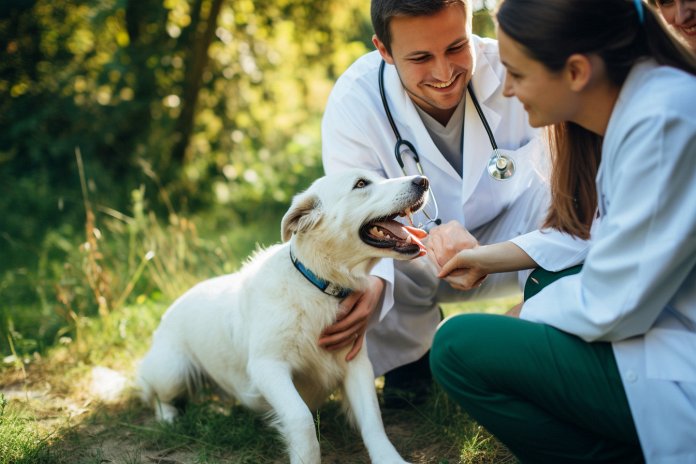
Parvovirus is a severe and potentially fatal virus that attacks dogs. It is highly contagious and primarily affects puppies. It causes acute gastrointestinal illness and requires immediate veterinary attention. The good news is that parvo is preventable and dogs can be successfully treated. It is important for dog owners to recognize the warning signs and act quickly to protect their pets. This article will discuss the causes, spread, and treatment of parvovirus.
Signs of Parvovirus in Dogs:
Parvo is caused by a virus called canine parvovirus type 2. It affects a dog’s gastrointestinal tract and cardiovascular system, leading to rapid onset of illness. The most common sign is severe, bloody diarrhea. Dogs may also experience repeated vomiting, dehydration, and damage to the intestines and immune system. Other symptoms include lethargy, weakness, lack of appetite, and fever or low body temperature. In rare cases, parvo can affect a puppy’s heart muscles and be fatal. Dogs of all ages can be affected by parvo, with puppies under five months being the most vulnerable. It is important to seek veterinary attention even if you are unsure if your dog has parvo or not.
Body Language:
Dogs may use body language to indicate that they are not feeling well. Signs of parvo can include whining, shaking, and weakness.
The History of Parvo:
Canine parvovirus type 2 emerged in Europe in the late 1970s and quickly spread worldwide, causing an epidemic in pet dogs. The veterinary community responded by studying and isolating the virus, leading to the development of effective vaccines. There are three variants of the virus, with type c being the most prevalent in the US. Despite vaccinations, parvo outbreaks still occur, so it is important to consult with a veterinarian for protection.
The Science of Parvovirus:
Canine parvovirus type 2 is closely related to feline panleukopenia virus. Parvo is highly infectious and can be spread through contact with infected feces, direct dog-to-dog contact, or contact with contaminated environments or objects. The virus can survive in the environment for up to a year and is resistant to heat, detergents, and alcohol. Not every dog exposed to the virus becomes infected, but those with compromised immune systems are at higher risk.
Parvovirus Treatment:
Parvovirus is a serious condition that requires immediate veterinary help. Diagnosis is usually done through a fecal test. Treatment focuses on providing support to the dog’s immune system until it can fight off the virus. Hospitalization in an isolation ward is often necessary, along with medications to prevent bacterial infections, IV fluids and nutrients to replace what is lost through vomiting and diarrhea, and sometimes blood transfusions to boost low blood cell counts. Most puppies who survive the first few days with parvovirus have a good chance of recovery, which usually takes about a week. Your veterinarian will guide you through the treatment process and create a recovery plan tailored to your puppy’s needs.
“Early detection and immediate veterinary attention are crucial in treating canine parvovirus.”

Tips & Things to Know
1️⃣ Parvovirus is a serious and potentially fatal disease in dogs that affects the gastrointestinal and cardiovascular system. If your dog shows symptoms such as sudden severe diarrhea, persistent vomiting, lethargy, weakness, loss of appetite, or fever, it is crucial to seek immediate veterinary attention.
2️⃣ Although there are effective vaccines for all variants of parvovirus, outbreaks still occur. Therefore, it’s important to speak with your vet about how best to protect your puppy or dog. Parvovirus can be spread by any animal, person, or object that comes into contact with the feces of an infected dog and can remain in the environment for up to a year.
3️⃣ If your dog gets infected with parvovirus, immediate treatment is needed as there’s no specific drug that can kill the virus. Treatment usually focuses on providing the support your dog needs until their immune system is strong enough to fight off parvo. This typically involves hospitalization in an isolation ward, IV fluids, and nutrients to replace what’s lost through vomiting and diarrhea, and possibly antibiotics or blood transfusions. Most puppies who survive the first few days of the infection are likely to recover, which usually takes about a week.
Frequently Asked Questions, Answered ✅
1. What are the signs and symptoms of parvovirus in dogs?
– Signs and symptoms of parvovirus in dogs include severe, bloody diarrhea, repeated vomiting, lethargy, weakness, loss of appetite, and fever or low body temperature.
2. Can parvovirus affect dogs of all ages?
– Yes, while it is most common in dogs under one year of age and most dangerous for pups of less than five months, parvovirus can affect dogs of all ages.
3. How did canine parvovirus type 2 first emerge?
– Canine parvovirus type 2 first emerged in Europe around 1978 and spread rapidly worldwide, causing an epidemic of gastrointestinal and heart problems in pet dogs.
4. How is parvovirus transmitted?
– Parvovirus can be spread by any animal, person, or object that comes into contact with the feces of an infected dog. It can also be transmitted through direct dog-to-dog contact or by coming into contact with an infected environment.
5. How is parvovirus treated in dogs?
– There is no specific drug that can kill the virus, so treatment focuses on providing supportive care until the dog’s immune system is strong enough to fight off the virus. This may include hospitalization, medication to prevent bacterial infections, IV fluids and nutrients, and sometimes blood transfusions.